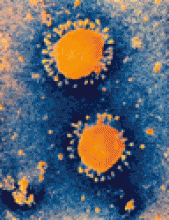- © 2004 Canadian Medical Association or its licensors
Ventolin, Serevent, Flovent Diskus recall
Several Diskus dry powder inhalers used in the treatment of asthma and chronic obstructive pulmonary disease are being recalled because they were manufactured incorrectly and may fail to deliver therapeutic drug doses.1 Specific lots of Ventolin, Serevent and Flovent Diskus products (Table 1) are affected by the defect, which occurs in less than 0.18% of the devices. Although Diskus products approved by the US Food and Drug Administration (FDA) for sale in the United States (Advair and Serevent) are not affected by the recall, the FDA has alerted American consumers about the Canadian recall because they may have obtained prescription drugs from Canada and elsewhere through online or storefront operations.2
Table 1.
Blue dye test: toxicities include blue discoloration and death
The dye FD&C Blue No. 1 (Blue 1; triphenylmethane) is sometimes added to enteral feeding solutions of critically ill patients to detect pulmonary aspiration. However, serious outcomes have been reported in some patients undergoing such tests. The FDA recently issued a warning that the test may result in rare but serious toxic effects, including blue–green discoloration of the skin and bodily fluids, refractory hypotension, metabolic acidosis and death.3
Blue 1 is a water-soluble dye used in a variety of foods and drugs because it is relatively nontoxic and poorly absorbed systemically at daily doses in the range of 12 mg/kg body weight.3 Unfortunately, many critically ill patients may have altered gastrointestinal permeability, in which case more of the dye would be absorbed systemically. In vitro the dye causes mitochondrial toxicity, which may be the mechanism behind many of the serious reported adverse effects.
Certain critically ill patients with altered gut permeability, such as those with sepsis, burns, shock, trauma, surgical interventions, renal failure, celiac sprue or inflammatory bowel disease, may be at increased risk of toxic effects from the blue dye test. The practicality and safety of different tests (e.g., glucose monitoring in secretions) and other blue dyes (methylene blue and FD&C Blue No. 2) is not yet clear.
Eric Wooltorton CMAJ











